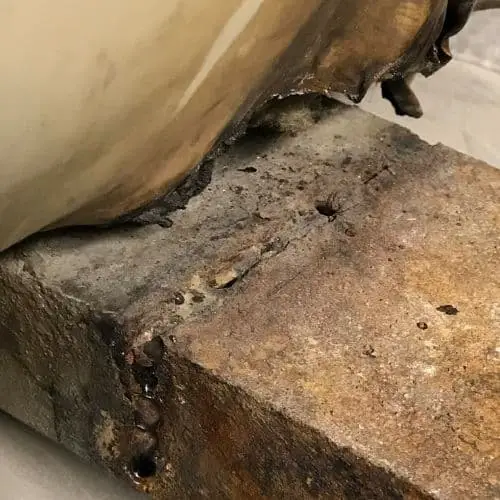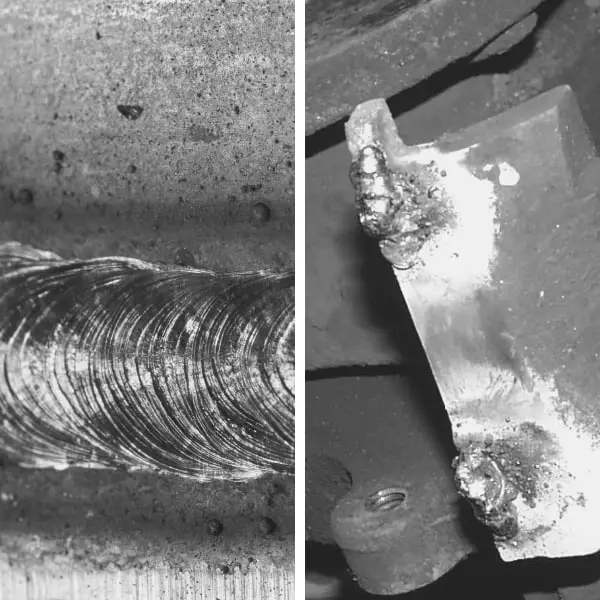
MIG Welding has simplified welding to a great extent and made welding easier for even beginners to learn quickly. Since the skill level required is much lesser for MIG welding, many people are taking up Metal Inert gas welding with limited training. But even though the process is simplified, it still can cause bad welds if the welding procedure is not followed properly. People who are tacking into gas metal arc welding can create inferior welds and in this article, we’ll look at the bad welds and causes and what does a good MIG weld look like.
MIG Welding issues can be generally categorized into 4 types including:
- Weld porosity
- Improper weld bead profile
- Lack of fusion
- Faulty wire delivery
Weld Metal Porosity
Contents
Improper Surface Conditions
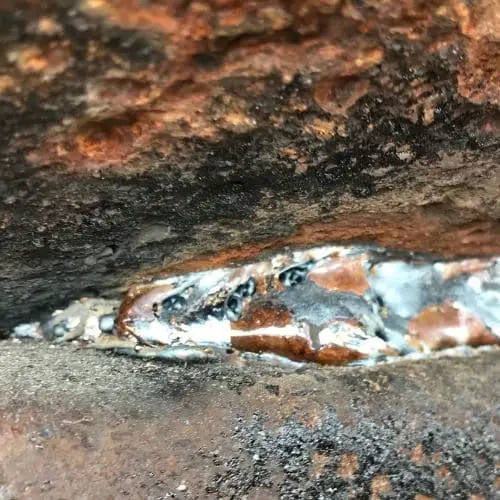
One of the most common causes of weld porosity is the surface condition during the welding process. If the surface is not balanced and is improper, it could lead to porosity in the output. If the base metal contains rust, oil, or paints on its surface, it will prevent proper penetration into the weld and lead to porosity. If you use a flux core wire or shielded metal arc welding, it tends to take care of the contaminants in the base metal as they contain components that can shield the metal from contaminants and reduce porosity to a great extent.
Remedies
To prevent porosity in the weld, it is better to make use of some sort of deoxidizer in the wire like silicon, aluminum or zirconium. Understand the wire chemistry for the welding job and test with different wires with a small piece of metal to determine the right kind of wire. Make sure the surface is clean from oil, rust and paint by using a grinder, wire brush or in some cases degreaser or even acetone before welding aluminum.
Gas Coverage
Another main cause that could lead to weld porosity in GMA welding is gas coverage. In wire feed welding, shielding gas is mainly used to protect the base metal from getting contaminated from the pollutants in the air and also acts as an arc stabilizer most of the time. But if the airflow is too strong and the shielding gas is distributed, then there is every possibility the base metal could get contaminated leading to porosity.
Remedies
The gas flow is largely determined by the size of the wire, amperage input, wire transfer method and the intensity of the wind around. Generally, it is recommended to have a gas flow rate of 30-40 cubic feet per hour and this can be determined by using a flow meter and check if the gas flow is within the specified range. Some people use a pressure regulator to control the gas flow, but a pressure regulator will not control the gas flow at any point. When you are using a shielding gas mixture that contains carbon dioxide, then it is recommended to use special flow meters that will help you gauge the correct gas flow rate. The reason you need special flow meters is because of the reason that frosting may occur when CO2 changes into a gas from a liquid form and these meters won’t be affected.
Base Metal Properties
Another reason that MIG weld may not look good is due to the base metal properties as if the sulfur content is too high in the base metal. That could lead to porosity as well.
Remedy
You cannot do anything except to use a metal that comes with the right kind of properties that will not create porosity. Hope the above points answer your question about how to prevent porosity in welding.
Improper Weld Bead Profile
Insufficient Heat Input
If the heat input is not enough then it could lead to not penetrating to the desired level into the base metal. If the bead is too convex, then it means that the MIG welding settings used for welding are too cold.
Remedies
To rectify this issue, the welder must check if the amperage supplied is correct for the thickness of the metal. Wire manufacturers and MIG welding machine manufacturers provide you with detailed charts and user manuals that provide you with all the information about the kind of gas flow rate, right amperage level, etc.
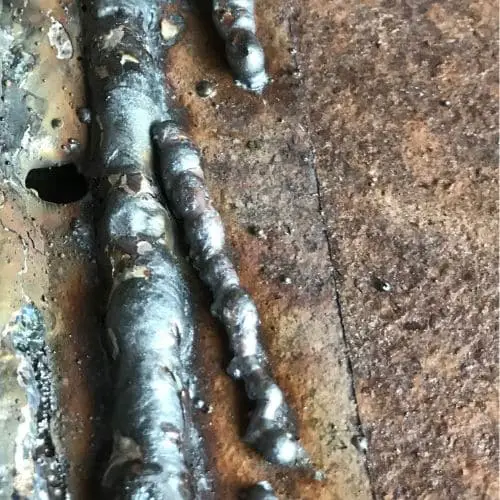
On the picture, you can see two welding beads, one uglier than the other. The one on the left is welded with correct amperage, but the wire feed speed was too fast, making the bead a little bit too high. On the right, the amperage is too low, but the wire feed speed is right, but still, the bead is too high, and that is because of the low amperage, it did not penetrate the base metal enough, resulting in bad and weak weld.
Welding Technique
If the bead profile is either convex or concave, then it may lead to a bad weld. In such cases, a proper technique like a push technique can help you to create a flatter bead, and that is how good looking MIG weld should look like. Also, keep an eye on the undercut.
Remedy
To get the correct bead shape in MIG welding, better go for a 5-10 degree push angle (Puch angle is even better when welding thick materials, helps with penetration) and check your amperage and wire feed speed. If you have undercut in the base metal your power settings are too high, if your bead is tall and round, you may have wrong travel speed, wire-speed or not enough output power, depending on the thickness of the material.
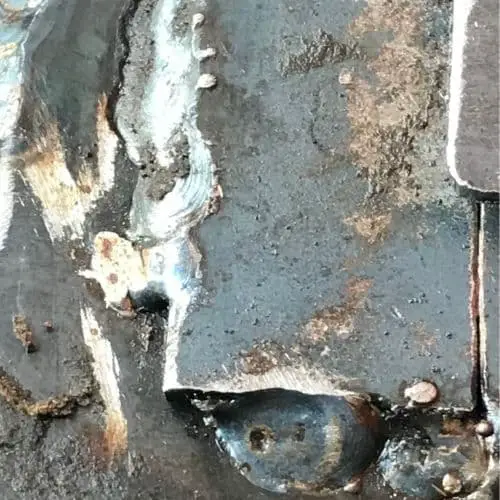
Inadequate Work Cable
If the work cable used for welding is inadequate, then it may lead to a bad weld.
Remedy
Better check the cable is you buy a used welder or you use an old welder, make sure all the cables are intact.
Lack of Fusion
Cold Lapping in the Short Arc Transfer Process
Many welders use the short arc transfer method during MIG welding as this process involves the electrode wire to touch the weld pool and create a short circuit that makes the wire to melt and drop at the metal. But if the energy is not sufficient then it will lead the weld pool to be fused within the base plate, but the metals will not be joined together. It may be hard to detect the lack of fusion and requires some kind of bend testing or ultrasonic testing to determine the lack of fusion issue.
Remedies
To provide the correct amount of fusion during the short arc transfer process, make sure you have set the amperage and the voltage settings properly. And if you still encounter the same problem again, then you better change your welding technique. Better make use of spray arc welding as the arc doesn’t get too cold cause fusion problems.
Faulty Wire Delivery
Another major issue that can cause a bad weld is faulty wire delivery. Once you have enough experience, you can tell when the machine is not delivering wire correctly. That might be a symptom of wire that was installed incorrectly or because of the dirty gun liner.
Remedy
Make sure that you use wire that is in a good condition not rusty or contaminated in some other way. Check your drive roll system and make sure that you have the right type and size drive roll in the machine.
Contact Tip
Welders can face contact issues of they use a contact tip that is oversized and it could even lead to porosity and poor bead shape.
Remedy
Ensure that you use the proper size contact tip and replace if it is oversized or wearing out.
Gun Liner
Similar to the contact tip, the gun liner also needs to be of the perfect size if you don’t want a bad weld at the end of the day, it is important that the gun liner is cleaned properly before welding.
Remedy
Use low-compressed air to clean the gun liner or if needed replace the gun liner to get a good weld.
Conclusion
Hope this article was helpful to help you determine what does a good MIG weld look like and how to determine bad welds causes. Most beginners forget to turn on the gas before they start welding, and that is the main reason why the welds look ugly, and the rest just comes down to practice and finding the right settings for the job.

To sum it up in short, the good weld has to look like in the third picture here, not too hollow or too tall, on the third picture you can see red circles, that is where the undercuts will be if your voltage is too high. You want your bead to be fairly leveled without sharp edges where the red circles are.
If you have any further questions, please drop us a comment below.
